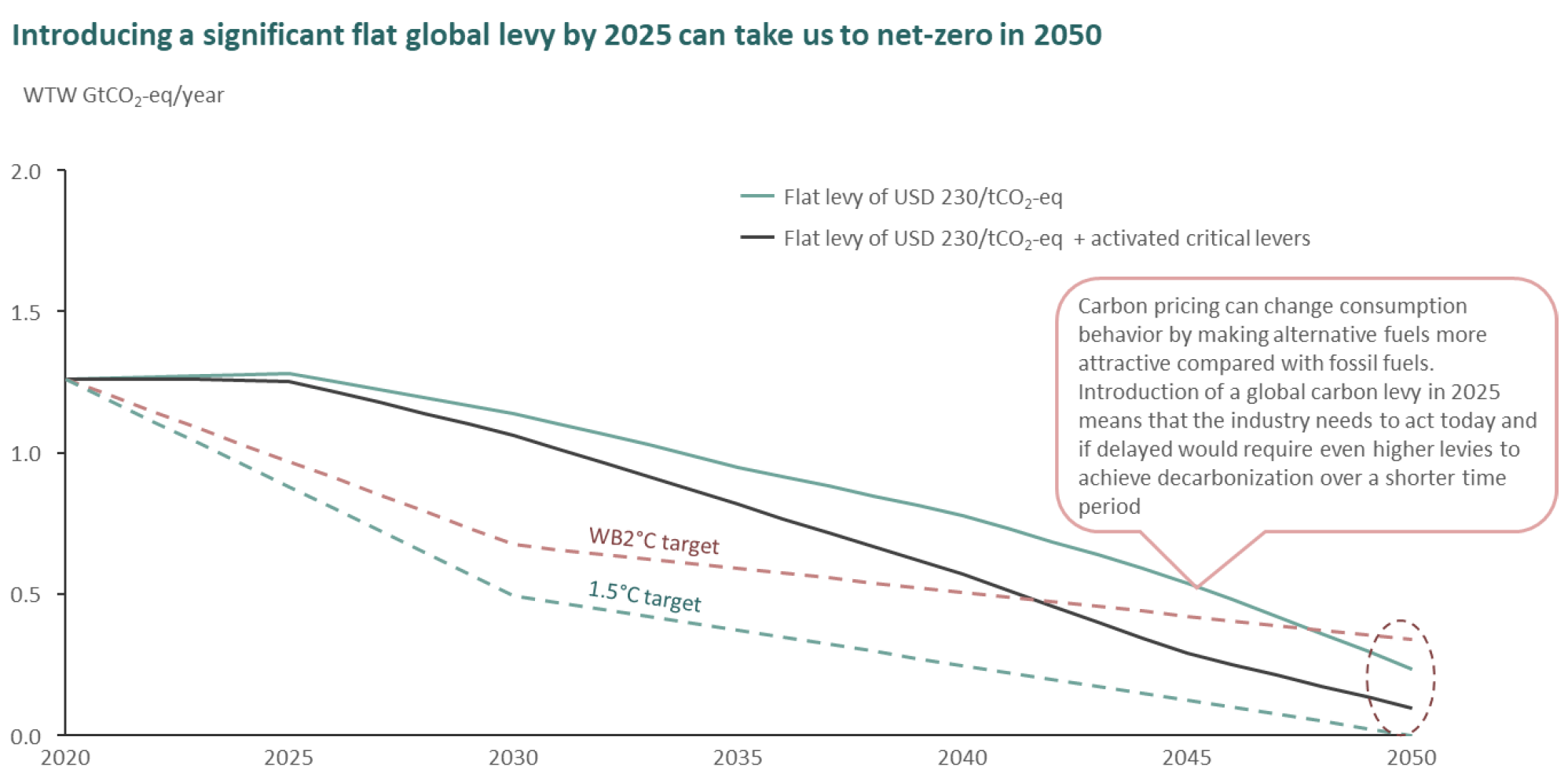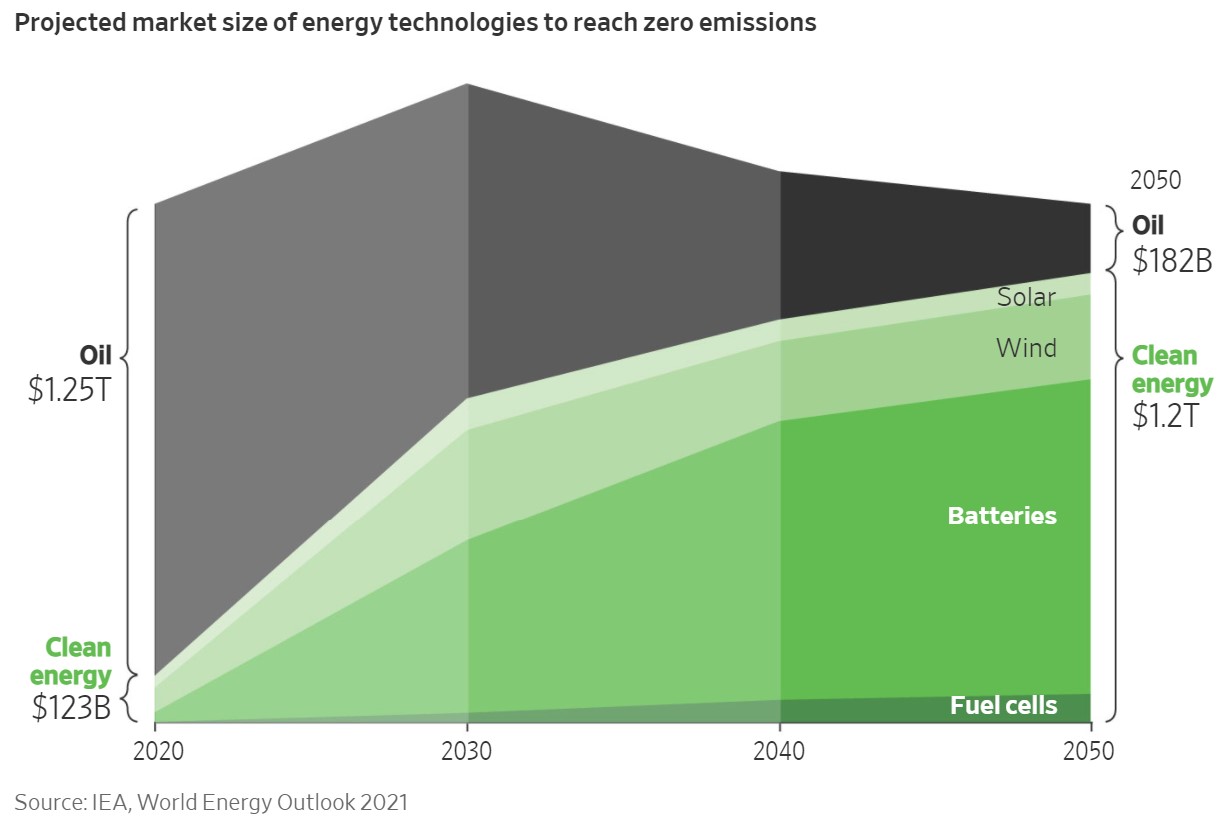

Hello friends! Here’s my monthly take on five most interesting developments in transport energy trends. What I try to do each month is select stories, studies and other interesting items that you may not have seen elsewhere but that really represents an important issue or trend that I think you would want to know about. Or I try to poke behind the hype to provide a deeper understanding of what’s happening. Items I selected this month include:
1. Reuters: Shipping Drifts Off Net-Zero Course without Carbon Levy-Study – Reuters reports that the global shipping industry is on course to see its GHG emissions rise by 20% by 2050 if action including introducing a carbon tax is not taken, new research released this week by Maersk McKinney Moller Center for Zero Carbon Shipping shows. What kind of carbon tax or levy are we talking about? The figure below, which I pulled from the report’s executive summary, shows a flat levy of US$230/tCO2 equivalent (CO2e) annually through 2050 can help the industry reach net zero. For comparison, Sweden currently has the highest carbon tax right now at US$137 MT/CO2e.

Source: Maersk McKinney Moller Center for Zero Carbon Shipping
The study suggests levy proceeds can be returned to early adopters of alternative fuels, lowering the cost of decarbonization for consumers. It also acknowledges that the future fuel mix will consist of several alternative fuels including electrofuels and biofuels, but they’ll need significant scaling.
Notably, leading shipping associations in September proposed creating a global levy on carbon emissions from ships to help speed up the industry’s efforts to go greener and submitted a proposal to the UN’s shipping agency, the International Maritime Organization.
2. Wall Street Journal: Behind the Energy Crisis: Fossil Fuel Investment Drops, and Renewables Aren’t Ready – We’re all in a collective pickle it seems and as I’ve said many times, this is going remain the case throughout much of this decade and beyond. This Wall Street Journal article notes that demand for oil, coal and natural gas has skyrocketed world-wide in recent weeks as unusual weather conditions and resurgent economies emerging from the pandemic combine to create energy shortages from China to Brazil to the U.K.
The situation has laid bare the fragility of global supplies as countries drive to pivot from fossil fuels to cleaner sources of energy, a shift many investors and governments are trying to accelerate amid concerns about climate change. And here’s the stark reality: While fossil fuel investment is falling, fossil fuels account for most energy and green energy spending isn’t growing fast enough to fill the gap. This is shown in the chart below.

Republished from The Wall Street Journal
The article notes that global oil and gas exploration spending, excluding shale, averaged about $100 billion a year from 2010 to 2015, but dropped to an average of around $50 billion in the years that followed after a crash in crude prices, according to Rystad Energy. Total global oil and gas investment this year will be down about 26% from pre-pandemic levels to $356 billion, the IEA said Wednesday. That is about where it would need to remain for the next decade, before declining further, to meet the goals of the Paris agreement, according to the IEA. To meet global energy demand, as well as climate aspirations, investments in clean energy would need to grow from around $1.1 trillion this year to $3.4 trillion a year until 2030.
3. ADM: ADM, Gevo Sign MoU to Produce up to 500M Gallons of Sustainable Aviation Fuel – I’ve been watching for this development for awhile and now it’s beginning to happen: the transition of ethanol production facilities that were traditionally focused on the gasoline/light-duty vehicle market to the burgeoning (and potentially more lucrative) sustainable aviation fuel (SAF) market. This trend will accelerate if a blender’s tax credit for SAF is instituted (and I expect it will be). The tax credit would take effect Jan. 1, 2023, and run through 2031, providing a $1.25 per gallon credit for each gallon of SAF with a lifecycle GHG reduction of at least 50 percent compared with conventional fuel. The credit increases by one cent up to $1.75 per gallon for each percentage point that the emissions reduction exceeds 50 percent.
The press release notes the ADM-GEVO memorandum of understanding (MoU) contemplates the production of both ethanol and isobutanol that would then be transformed into renewable low carbon-footprint hydrocarbons, including SAF, using Gevo’s processing technology and capabilities. About 900 million gallons of ethanol produced at ADM’s dry mills in Columbus, Nebraska, and Cedar Rapids, Iowa, as well as its Decatur, Illinois, complex, is expected to be processed utilizing this technology, resulting in approximately 500 million gallons of SAF and other renewable hydrocarbons. The isobutanol is expected to be produced at a proposed new facility in Decatur that would employ ADM’s carbon capture and sequestration capabilities.
4. Bloomberg: The Dangerous Promise of the Self-Driving Car – There’s some seriously straight talk about the future of autonomous vehicles in this article from Peter Norton, a renown historian from the University of Virginia in the U.S. The article discusses his new book, Autonorama: The Illusory Promise of High-Tech Driving. And wow, he has thoughts about the potential (or lack thereof) of the autonomous vehicle. Think comparisons not only to Big Tobacco but to Purdue Pharma and Oxycontin. I won’t even bother to summarize, but rather reproduce his comments on the subject.
“With autonomous vehicles it’s both: It can’t work, but the companies will create problems because they’ll pursue it anyway…Waymo likes to claim that autonomous vehicles are working right now. The reason it works is that there is a hellscape that these things have to go through, called Chandler, Arizona. Density is too low for anything other than driving to work well, every residential street is too wide, the non-residential roads are all multilane arterials with turning lanes, and every destination is surrounded by a vast parking lot. If that’s what you have to create for autonomous vehicles to work, it’s a Pyrrhic victory. It’s not worth it.
If we could go back to the 1990s and hear Purdue Pharma talk about OxyContin solving everyone’s problems, we’d be in righteous wrath. We’ve fallen for it with opioids; we don’t have to fall for it with autonomous vehicles.”
When asked whether he was suggesting that autonomous vehicle companies know that their products will damage society, but are still insisting on going forward, he said:
“Yes, that’s exactly what I mean. Although to say that the autonomous vehicle companies ‘know it’ might be a little unfair, because they really don’t care. They’re trying to get ahead in an intensely competitive environment, and the company that cares about reality is going to be the loser, because it will limit its deployment.
Uber had to know it was taking indefensible chances with lives every day in Tempe [prior to its prototype autonomous vehicle fatally striking Elaine Herzberg in 2018]. But Uber was also smart, in that the company recognized that any company that doesn’t take a risk has no future in the autonomous vehicle business.”
5. New York Times: What Will It Take for Electric Vehicles to Create Jobs, Not Cut Them? – Well, according to a recent report released by the Economic Policy Institute in the U.S., it will take government subsidies that are specifically focused on developing the supply chain for EVs as well as increasing demand for EVs (already under discussion in the infrastructure legislation Congress is considering) to make that happen.
The report found that without additional government investment, the industry could lose about 75,000 jobs by 2030, the year by which the President wants half the new vehicles sold in the country to be electric. However, if the article reports that if government subsidies were targeted to increase the portion of EV components that are manufactured domestically, and to increase the market share of U.S.-made vehicles, the industry could add about 150,000 jobs by the end of the decade. EVs require 30% less or more labor to manufacture parts as compared to an internal combustion engine.
Despite subsidies being considered in Congress that could be as much as US$12,500, with an additional $4,500 that would apply to vehicles assembled at unionized factories domestically, there is not (yet) a specific subsidy scheme that would apply to the supply chain. Moreover, the supply chain is challenging in one important respect – batteries.
The Times notes that according to a report this year by the Center for Strategic and International Studies and Bloomberg New Energy Finance, well over half the value of batteries used in U.S.-made EVs accrued to companies based abroad, primarily South Korea, Japan and China. By contrast, in China 100 percent of the value of a finished battery tends to accrue locally. Moreover, Chinese, Japanese and South Korean battery makers continued to source the most valuable battery parts from their home countries well after they set up assembly plants in other parts of the world, such as in Europe.
Tammy Klein is a consultant and strategic advisor providing market and policy intelligence and analysis on transport energy to the auto and oil industries, alternative fuels industries, governments and NGOs. She writes and advises on petroleum fuels, biofuels and other alternative fuels, and fuels policy, market and technology issues.